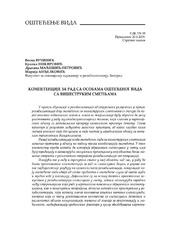Приказ основних података о документу
The competence for the work with visually impaired children with additional disabilities
Kompetencije za rad sa osobama oštećenog vida sa višestrukim smetnjama
| dc.creator | Vučinić, Vesna | |
| dc.creator | Eškirović, Branka | |
| dc.creator | Maćešić-Petrović, Dragana | |
| dc.creator | Anđelković, Marija | |
| dc.date.accessioned | 2021-06-09T13:28:30Z | |
| dc.date.available | 2021-06-09T13:28:30Z | |
| dc.date.issued | 2009 | |
| dc.identifier.issn | 0354-8759 | |
| dc.identifier.uri | http://rfasper.fasper.bg.ac.rs/handle/123456789/285 | |
| dc.description.abstract | In addition to basic pedagogic knowledge and the knowledge in special pedagogy, in the rehabilitation and education practice, the experts involved in the process of rehabilitation of visually impaired children with additional disabilities are expected to be trained to participate in the work of multidisciplinary teams, whose members, in partnership relations with parents, create a complex approach to a child. Such approach is the result of mutually depending approaches, non of them having any importance when not being a part of the whole and if it has not been created with other tangent disciplines. The development of the rehabilitation of visually impaired children with additional disabilities can be followed in relation to the classification according to the combination of impairments. In this context, it is worth to emphasize that the history of the education of deafblind children has very long tradition and, owing to meritorious zealous workers, we can talk today about various theories of the rehabilitation of this population. Bearing this in mind, as well as the current situation in our country concerning this area, the competences for the work with deafblind children will be presented in this work, and they are just those who introduce us most directly into the complexity of the rehabilitation of the population being separated from the world of objects by their visual impairment, and from the world of people by their hearing impairment, and these impairments together lead into isolation. The competences are defined on the basis of rich practical experience in the rehabilitation of deafblind persons in the world, but also owing to the cooperation among the experts working in vertically connected educational institutions, as well as owing to the mentioned theories, i.e. methodical approaches in the rehabilitation which stress the importance of knowledge on general issues of deafblindness, issues concerning the establishing of contact with a deafblind child and different forms of communication, issues important for orientation and mobility, modification of environmental factor with the aim of ensuring optimum conditions for receiving information from outside, as well as multidisciplinary cooperation. | en |
| dc.description.abstract | U praksi edukacije i rehabilitacije od stručnjaka uključenih u proces rehabilitacije dece oštećenog sa višestrukim smetnjama se očekuje da pored opštih pedagoških znanja i znanja iz tiflologije budu obučeni da mogu učestvovati u radu multidisciplinarnih timova, čiji članovi u partnerskom odnosu sa roditeljima kreiraju kompleksan pristup detetu. Takav pristup je rezultat međusobno zavisnih pristupa, od kojih nijedan nema značaja ukoliko nije deo celine i nije nastao u saradničkom odnosu sa ostalim tangentnim disciplinama. Razvoj rehabilitacije osoba oštećenog vida sa višestrukim smetnjama možemo pratiti u odnosu na podelu prema kombinaciji oštećenja. U tom kontekstu treba istaći da istorija obrazovanja slepogluvih u svetu ima dugu tradiciju i zahvaljujući zaslužnim pregaocima u ovoj oblasti danas možemo govoriti o različitim teorijama rehabilitacije ove populacije. Imajući to u vidu i trenutno stanje u ovoj oblasti kod nas, u radu će biti prezentovane kompetencije za rad sa slepogluvom decom, a upravo one nas najdirektnije upućuju na kompleksnost rehabilitacije, populacije koju oštećenje vida odvaja od sveta predmeta a oštećenje sluha od sveta ljudi i zajedno vode u izolaciju. Definisane su na osnovu bogatih praktičnih iskustava u rehabilitaciji slepogluvih u svetu, zatim zahvaljujući saradnji među stručnjacima koji rade u vertikalno povezanim obrazovnim institucijama, kao i pomenutim teorijama, odnosno metodskim pristupima u rehabilitaciji, koji ističu značaj poznavanja opštih pitanja slepogluvoće, pitanja koja se tiču uspostavljanja kontakta sa slepogluvim detetom i različitih oblika komunikacije, pitanja od značaja za orijentaciju i mobilnost, modifikaciju sredinskih faktora u cilju obezbeđivanja najoptimalnijih uslova za prijem informacija iz spoljašnje sredine, kao i multidisciplinarne saradnje. | sr |
| dc.publisher | Univerzitet u Beogradu - Fakultet za specijalnu edukaciju i rehabilitaciju, Beograd | |
| dc.rights | openAccess | |
| dc.source | Beogradska defektološka škola | |
| dc.subject | visually impaired persons with additional disabilities | en |
| dc.subject | deafblind persons | en |
| dc.subject | competences | en |
| dc.subject | osobe oštećenog vida sa višestrukim smetnjama | sr |
| dc.subject | slepogluve osobe | sr |
| dc.subject | kompetencije | sr |
| dc.title | The competence for the work with visually impaired children with additional disabilities | en |
| dc.title | Kompetencije za rad sa osobama oštećenog vida sa višestrukim smetnjama | sr |
| dc.type | article | |
| dc.rights.license | ARR | |
| dc.citation.epage | 114 | |
| dc.citation.issue | 1 | |
| dc.citation.other | (1): 101-114 | |
| dc.citation.rank | M52 | |
| dc.citation.spage | 101 | |
| dc.identifier.fulltext | http://rfasper.fasper.bg.ac.rs/bitstream/id/369/282.pdf | |
| dc.identifier.rcub | https://hdl.handle.net/21.15107/rcub_rfasper_285 | |
| dc.type.version | publishedVersion |


